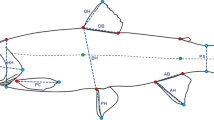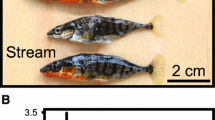Abstract
Ecological character displacement (ECD) provides opportunities to test how resource competition generates diversifying selection that results in adaptive divergence. We quantify an association between phenotypic and ecological divergence between two similar small fishes, brook (Culaea inconstans) and ninespine (Pungitius pungitius) sticklebacks, in replicate northern Ontario lakes, Canada. The two species partition resources and habitat, where they coexist, and brooks that coexist with ninespines are more benthically specialized in body form and diet than brooks from local allopatric populations. Here we test various explanations for this pattern. Chance is unlikely to have been the primary cause because divergence is replicated in three separate populations. Preliminary comparisons indicate that resource availability and a variety of abiotic ecological conditions are generally similar between sympatric and allopatric sites, and so do not readily account for the divergence. Biased colonization or extinction is less likely to account for the divergence because character values in sympatry tend to exceed those in allopatry, as expected if they have repeatedly evolved under diversifying selection. Recent studies have also demonstrated that these two species compete, and that competitive effects are more severe for allopatric compared to sympatric brook forms, as predicted if divergence reflects the ghost of competition past. Ongoing studies indicate heritable variation in this system. Our results suggest that even small amounts of character shifts can influence competition and hence relative fitness, further implicating a role for ECD in the evolution of biodiversity.



Similar content being viewed by others
References
Adams DC (2004) Character displacement via aggressive interference in Appalachian salamanders. Ecology 85:2664–2670
Adams DC, Slice DE, Rohlf FJ (2004) Geometric morphometrics: Ten years of progress following the “revolution”. Ital J Zool 71:5–16
Bernatchez L, Wilson C (1998) Comparative phylogeography of Nearctic and Palearctic fishes. Mol Ecol 7:434–452
Bolnick DI (2004) Can intraspecific competition drive disruptive selection? An experimental test in natural populations of sticklebacks. Evolution 58:608–618
Bolnick DI, Yang LH, Fordyce JA, Davis JM, Svanback R (2002) Measuring individual-level resource specialization. Ecology 83:2936–2941
Bolnick D, Svanback R, Fordyce JA, Yang LH, Davis JM, Hulsey CD, Forister ML (2003) The ecology of individuals: incidence and implications of individual specialization. Am Nat 161:1–28
Bookstein FL (1991) Morphometric tools for landmark data: geometry and biology. Cambridge University Press, New York
Brown WL, Wilson EO (1956) Character displacement. Syst Zool 5:49–64
Clarke AS (1954) Studies on the life cycle of the pseudophyllidean cestode Schistocephalus solidus. Proc Zool Soc Lond 124:257–303
Connell JH (1980) Diversity and the coevolution of competitors, or the ghost of competition past. Oikos 35:131–138
Connelly J (1972) Swastika District History. Ontario Ministry of Natural Resources (unpublished report)
Day T, Young KA (2004) Competitive and facilitative evolutionary diversification. BioScience 54:101–109
Ehlinger TJ (1990) Habitat choice and phenotype-limited feeding efficiency in bluegill: individual differences and trophic polymorphism. Ecology 71:886–896
Grant PR (1972) Convergent and divergent character displacement. Biol J Linn Soc 4:39–68
Gray SM, Robinson BW (2002) Experimental evidence that competition between stickleback species favours adaptive character divergence. Ecol Lett 5:264–272
Hatfield T (1997) Genetic divergence in adaptive characters between sympatric species of stickleback. Am Nat 149:1009–1029
Hopkins CA, Smyth JD (1951) Notes on morphology and life history of Schistocephalus solidus. Parasitology 41:283–291
Jastrebski CJ, Robinson BW (2004) Natural selection and the evolution of replicated trophic polymorphisms in pumpkinseed sunfish (Lepomis gibbosus). Evol Ecol Res 6:285–305
Keast A, Webb D (1966) Mouth and body form relative to feeding ecology in the fish fauna of a small lake, Lake Opinicon Ontario. J Fish Res Board Can 23:1845–1874
Konovalov SM (1995) Parasites as indicators of biological processes, with special reference to sockeye salmon (Oncorhynchus nerka). Can J Fish Aquat Sci 52:202–212
Lack D (1947) Darwin’s finches. Cambridge University Press, Cambridge
McLennan DA (1996) Integrating phylogenetic and experimental analyses: the evolution of male and female nuptial coloration in the stickleback fishes (Gasterosteidae). Syst Biol 45:261–277
McPhail JD (1994) Speciation and the evolution of reproductive isolation in the sticklebacks (Gasterosteus) of southwestern British Columbia. In: Bell MA, Foster SA (eds) Evolutionary biology of the threespine stickleback. Oxford University Press, Oxford, pp 399–437
Melville J (2002) Competition and character displacement in two species of scincid lizards. Ecol Lett 5:386–393
Nagel L, Schluter D (1998) Body size, natural selection, and speciation in sticklebacks. Evolution 52:209–218
Pacala SW, Roughgarden J (1985) Population experiments with Anolis lizards of St. Maarten and St. Eustacious. Ecology 66:129–141
Parsons KJ, Roninson BW, Hrbek T (2003) Getting into shape: an empirical comparison of several traditional truss-based methods with a newer geometric method applied to New World cichlids. Environ Biol Fish 67:417–431
Peckarsky BL, Fraissinet PR, Penton MA, Conklin DJ (1990) Freshwater macroinvertebrates of Northeastern North America. Cornell University Press, Ithaca
Pfennig DW, Murphy PJ (2002) How fluctuating competition and phenotypic plasticity mediate species divergence. Evolution 56:1217–1228
Pfennig DW, Murphy PJ (2003) A test of alternative hypotheses for character divergence between coexisting species. Ecology 84:1288–1297
Pielou EC (1991) After the Ice Age: The return of life to glaciated North America. University of Chicago Press, Chicago, pp 5–38
Pritchard JR, Schluter D (2001) Declining competition during character displacement: summoning the ghost of competition past. Evol Ecol Res 3:209–220
Robinson BW (2000) Trade offs in habitat-specific foraging efficiency and the nascent adaptive divergence of sticklebacks in lakes. Behaviour 137:865–888
Robinson BW, Schluter D (2000) Natural selection and the evolution of adaptive genetic variation in northern freshwater fishes. In: Mousseau TA, Sinervo B, Endler JA (eds) Adaptive Genetic Variation in the Wild. Oxford University Press, Chicago, pp 65–94
Robinson BW, Wilson DS (1994) Character release and displacement in fishes: a neglected literature. Am Nat 144:596–627
Robinson BW, Wilson DS, Shea GO (1996) Trade-offs of ecological specialization: an intraspecific comparison of pumpkinseed sunfish phenotypes. Ecology 77:170–178
Rohlf FJ (2002) Geometric morphometrics in phylogeny. In: Forey P, Macleod N (eds) Morphology, shape and phylogenetics. Francis & Taylor, London#1059
Rundle HD, Vamosi SM, Schluter D (2003) Experimental evidence of predation’s effect on divergent selection during character displacement in sticklebacks. Proc Natl Acad Sci 100:14943–14948
Ruppert EE, Barnes RD (1994) Invertebrate zoology, 6th edn. Saunders College Publishing, Fort Worth, pp 175–193
Schluter D (1993) Adaptive radiation in sticklebacks: size, shape, and habitat use efficiency. Ecology 74:699–709
Schluter D (1996) Ecological speciation in postglacial fishes. Philos Trans R Soc Lond B 351:807–814
Schluter D (2000) The ecology of adaptive radiation. Oxford University Press, Oxford
Schluter D (2003) Frequency dependent natural selection during character displacement in sticklebacks. Evolution 57:1142–1150
Schluter D, McPhail JD (1992) Ecological character displacement and speciation in sticklebacks. Am Nat 140:85–108
Scott WB, Crossman EJ (1998) Freshwater fishes of Canada. Galt House Publications, Oakville, Ontario
Simpson GG (1953) The major features of evolution. Columbia University Press, New York
Skulason S, Smith TB (1995) Resource polymorphisms in vertebrates. Trends Ecol Evol 10:366–370
Thompson DW (1917) On growth and form. Cambridge University Press, Cambridge
Trends in Ecology and Evolution (2001) Special Issue: Speciation. Trends Ecol Evol 16:325–413
Webb PW (1984) Form and function in fish swimming. Sci Am 251:58–68
Wilson DS, Muzzall PM, Ehlinger TJ (1996) Parasites, morphology, and habitat use in a bluegill sunfish (Lepomis macrochirus) population. Copeia 1996:348–354
Wooton RJ (1976) The biology of the sticklebacks. Academic, London
Zar JH (1999) Biostatistical analysis, 4th edn. Prentice Hall, New Jersey
Acknowledgments
We thank C. Jastrebski, D. Bolnick, P. Nosil, D. Noakes, T. Nudds, A. Pomeroy, and two anonymous reviewers for insightful comments or discussion. The identification and analysis of parasite data was generously performed by A. Choudhury and J. Kurtis, respectively. A. Margosian, A. Tucker, C. LeClair, G. Hines, and the helpful staff at Esker Lakes Provincial Parks all provided much logistical field support. Funding for this study was provided by a Natural Sciences and Engineering Research Council of Canada Discovery grant, and a Premier’s Research Excellence Award, Ontario to B.W.R. This research was conducted in compliance with Canadian guidelines on animal care.
Author information
Authors and Affiliations
Corresponding author
Additional information
Communicated by Thomas Miller
Electronic supplementary material
Rights and permissions
About this article
Cite this article
Gray, S.M., Robinson, B.W. & Parsons, K.J. Testing alternative explanations of character shifts against ecological character displacement in brook sticklebacks (Culaea inconstans) that coexist with ninespine sticklebacks (Pungitius pungitius). Oecologia 146, 25–35 (2005). https://doi.org/10.1007/s00442-005-0184-3
Received:
Accepted:
Published:
Issue Date:
DOI: https://doi.org/10.1007/s00442-005-0184-3




